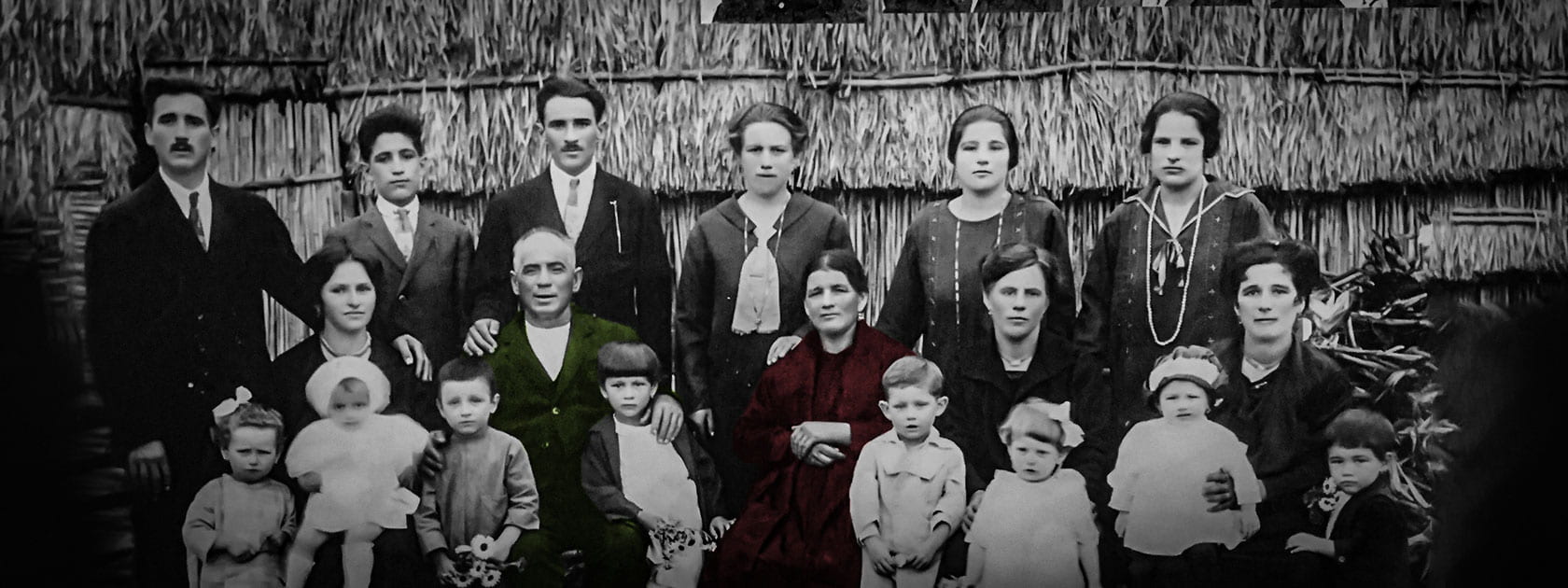Date
May 21, 2011
Maker
Columbus Centre
Accession#
ICEA2011.0023.0001
Interview 1 With Fernada Colangelo
Fernada Colangelo is the wife of internee, Berlino Colangelo, who was interned in Petawawa by the Canadian government for roughly two years. Fernada was born and raised in Hamilton, where she met her husband. She recalls the events of Berlino’s internment, which occurred before they were married, and while she was still in high school. She describes the East End Hamilton community as being very closely involved with the church and notes that the community was very upset and people were afraid to mix in groups after war was declared. Fernada describes how Berlino was heavily involved in the community via various organizations which likely accounted for his arrest and internment. Although the family was never allowed to visit him at the camp, Berlino kept in contact with his father via letters. Fernada further describes the activities that the internees were involved in at the internment camp to keep themselves occupied. She believes that the internees were not treated badly, however after their release from camp many found it difficult to find work and had to rely on welfare and assistance from the Hamilton community churches. Fortunately, Berlino was able to get a job right away, and they were married a year after his release. Overall, Fernada notes that the emotional impact of the internment process for internees and their families alike was very difficult, but the will to survive and move forward prevailed.
In this opening clip Fernada Colangelo introduces herself and provides some brief information about her family and the neighbourhood she grew up in as a child.
Fernada Colangelo provides information about her school, church and working life in the east end of Hamilton prior to her marriage to Berlino Colangelo.
In this clip Fernada Colangelo talks about her husband Berlino Colangelo. She mentions that he migrated to Canada from Italy and that their families were paesani.
Fernada Colangelo discusses the events of June 10, 1940 when Berlino Colangelo was arrested. She remembers going to evening mass and the priest being upset at the events of the day. The community members were fearful to gather in large groups and were unsure of who would be picked up next.
Fernada Colangelo briefly describes the arrest and eventual internment of Berlino Colangelo. Berlino was eventually interned at Camp Petawawa and kept in touch with his father via letters.
Fernada Colangelo explains that prior to the war Berlino Colangelo was involved with a number of Italian Canadian organizations in Hamilton and that his involvement in these organizations is what lead to his eventual arrest and internment.
Fernada Colangelo provides the internment and release dates for Berlino Colangelo.
Fernada Colangelo discusses the activities Berlino Colangelo and his fellow internees engaged in to keep busy while interned at Camp Petawawa.
Fernada Colangelo believes that the Italian Canadian internees were not treated badly while they were interned as they were provided three meals a day and a place to sleep.
Fernada Colangelo mentions that Berlino Colangelo knew many of the internees in Petawawa and that he kept in touch with many of them even after his release.
In this clip Fernada Colangelo discusses the discrimination faced by Italian Canadian students in her school. She also mentions that the families of the interned had a difficult time finding work and making ends meet during this period. Many relied on government relief and the support of other community members and the church for survival.
Fernada Colangelo describes the day that Berlino Colangelo returned home from his internment. She also mentions that he was quickly able to return to his previous place of employment upon his return.
Fernada Colangelo shares that her husband Berlino was not happy about his internment and found the experience degrading but moved on after his release.
In this closing clip Fernada Colangelo shares her feelings on the internment experience.
Date
August 07, 2011
Maker
Columbus Centre
Accession#
ICEA2011.0023.0002
Interview 2 With Fernada Colangelo
In her second interview, Fernada Colangelo talks more about her family. Her father, Francesco Paolo De Rubeis came to Canada in 1906, but returned home to marry Esterina Quaglia. Esterina and her 10 year old daughter, Irma, reunited with Francesco in Canada in 1920. Two years later, Fernada was born. The family first lived on Beach Rd., and then on Barnsdale Ave., and then finally on Minto Ave. in Hamilton. Fernada went to St. Anne’s elementary school, then Cathedral High School and then continued on for a fifth year at Cathedral Commercial. After school she worked at International Harvest in the payroll office. Fernada’s husband, Berlino Colangelo, came to Canada in 1930 at the age of 16, to join his father, Urbano Colangelo. The De Rubeis and the Colangelos were paesani. Berlino worked as a tailor at Coppley Noyes and Randall for 45 years. During World War II, Berlino was interned at Camp Petawawa for 22 months. The couple married in 1943 after Berlino’s release from the camp and they have six children. Fernada recalls that her husband found the Petawawa experience demoralizing. Italian Canadians in Hamilton were afraid that they would be the next to be interned if they spoke about it or tried to do anything. Fernada also speaks a bit about attending after-school classes at the Casa d’Italia and attending Sunday night variety shows there.
In this opening clip Fernada Colangelo talks about her parents and sister.
Fernada Colangelo briefly speaks of the ethnic makeup of the street she grew up on in Hamilton.
Fernada Colangelo mentions the name of the school and church she attended while growing up in Hamilton.
In this clip Fernada Colangelo describes first meeting her husband, Berlino Colangelo, as a young girl.
Fernada Colangelo speaks about the family of her husband Berlino Colangelo. She mentions that Berlino immigrated to Canada on his own in the early 1900s to join his father, while his mother and siblings did not join the family until after the war was over.
Fernada Colangelo mentions that her husband Berlino worked for Coppley Noyes and Randall when he immigrated to Canada and remained there for 45 years. Berlino continued his work as a tailor even while he was interned, hemming pants for fellow internees.
Fernada Colangelo recalls the details of June 10, 1940 when her husband Berlino Colangelo and other members of the Italian Canadian community in Hamilton were arrested.
In this clip Fernada Colangelo mentions that her father-in-law was designated an enemy alien during the war and had to report to the local authorities in Hamilton. She also speaks of Berlino’s internment at Camp Petawawa.
Fernada Colangelo describes her husband’s feelings regarding his internment once he was released and he returned home.
Fernada Colangelo describes the reaction of the Italian Canadian community in Hamilton to the news of the internments.
Fernada Colangelo describes how her family and the families of other internees coped while they had family members interned.
Fernada Colangelo describes the fear that existed in the Italian Canadian community during the war years. She also describes some of the discrimination the Italian Canadian community faced in Hamilton.
Fernada Colangelo speaks about the fear that existed in the community during the internment period. She also explains how the parish priest would assist the families of the interned, as would other community members.
Fernada Colangelo speaks about the events and activities she participated in at the Casa d’Italia in Hamilton prior to the war.
Fernada Colangelo describes the fear that existed in the Italian Canadian community in Hamilton. She also mentions that the local authorities used informants to create lists of community members to intern.
In this clip Fernada Colangelo mentions that when the interned when returned home they would often speak amongst themselves about the experience. Overall they felt bitter about the experience and found the experience demoralizing. She also speaks briefly about the redress efforts of a number of the men in the Hamilton community.



